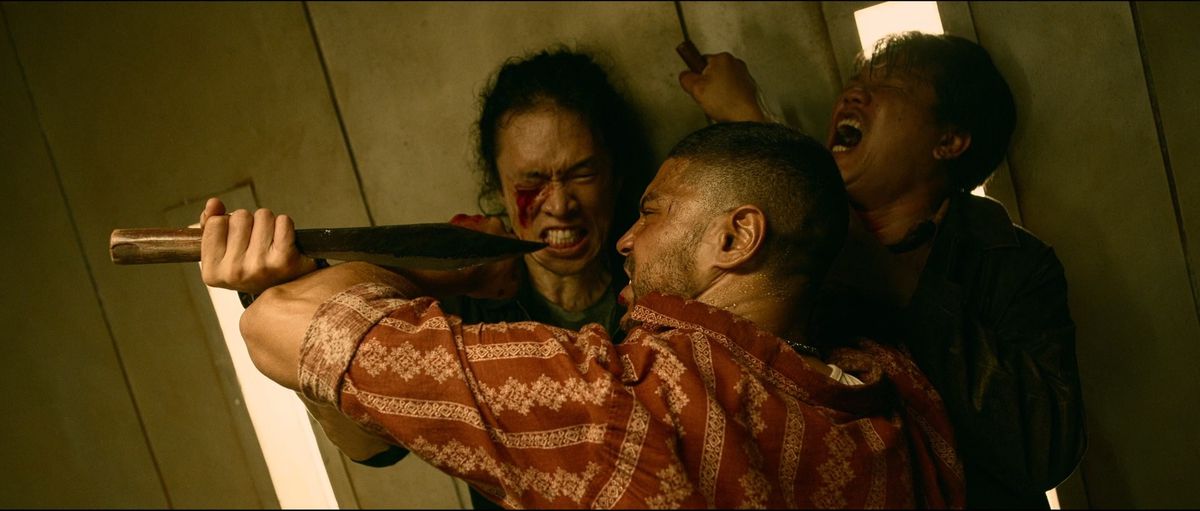How chaos! created one of the best elevator fight scenes in action movie history
2024 started off with a bang for action fans with the release of Bend!the excellent new revenge thriller from some of the people behind it Gangs of London. The film isn’t just an action brawl; he stands out from many of his peers with a heartfelt story that doesn’t feel like window dressing. But when the action hits, it really hits.
Polygon spoke with director Xavier Gens, action designer and second unit director Jude Poyer, and star Nassim Lyes, who joined forces to create a film with evocative choreography and camera movements that simultaneously build toward a compelling story and a thematic ending. Lyes is a former national welterweight kickboxing champion in France Bend! let him deliver a breakthrough performance. In the meantime, Gens and Poyer’s experiences continue Gangs of London, along with the deep wealth of knowledge that martial arts film fanatic Poyer brings to the project, make the action scenes feel fresh and energetic.
But in the era of COVID-19, it wasn’t easy to get so many talented people involved in a film. It required a huge amount of preparatory work, which had to be carried out by different teams around the world.
While Gens shot drama scenes or scouted locations in Thailand, Poyer (based in England) worked with the action team on pre-viz and choreography. The pre-viz (a technique in which versions of the action scenes are filmed in a gym or studio, to create a kind of live-action storyboard) would be sent to Gens, and after his stamp of approval to the French stunt coordinator. Olivier Sa. He would then teach Lyes the choreography and rehearse with him in France.
“This was truly a pandemic experience with a lot of remote work,” Poyer said. “Even though it was quite a different experience, by the time we all showed up in Thailand in early 2022, we had a very clear vision of what to do with those sequences.”
Image: IFC Films
All that preparatory work paid off. When a lead actor fell ill just before shooting a crucial scene, the team shifted to shooting other scenes without missing a single second because each department knew exactly what was required of them.
“In our view, it is not a blocking tape. It’s ‘These are the shots,’” Poyer says. “You’ll make small adjustments based on performance or rhythm, or the reality of the day, but it’s very specific shot-by-shot motivated camera work, motivated camera movements and editing points.”
The sequence that best illustrates the effectiveness of this careful approach is a frenetic series of battles between the corridor and the elevator. Bend!‘s third act. Vengeful protagonist Samir (Lyes) fights his way through a hallway full of bad guys with the help of a friend, then heads to a crowded elevator for more action.
The fights are interconnected and flow directly from one to the other, but they couldn’t be more different from each other. In the hallway, Samir and his many opponents have room to maneuver, dodge blows and deliver big, punishing hits. In the elevator, the cramped space completely changes the dynamics and choreography, even becoming a deadly weapon. Poyer and Gens appropriately increase the level of bloodshed in this part of the film, heightening the sense of danger as Samir fights for his life.

Image: IFC Films
“I want the audience to feel like this guy who just beat up 15 people could easily die,” Poyer says. “It’s about a change in tone, and a change in mood.”
In addition to Lyes’ striking performance and the brutal choreography, Bend!‘s use of the confined space helps distinguish it from other elevator fight scenes. That’s because Poyer and his team refused to cheat on the tight space: they used a realistically sized elevator and only removed a wall once to make room for the camera.
“We’ve probably all seen elevator fights where it feels like you can spin a car around in it,” Poyer says. “But it wasn’t like we built a bigger set to make it easier for the stunt performers and the camera to all dance around each other. I wanted that claustrophobic feeling. I wanted it to sometimes feel like the camera movement is a little behind the action going on. Like it’s playing catch-up, because I like fights that feel like fights.
Part of Poyer’s process involves treating the sequences as real fights, which makes them feel lifelike. He will put himself in the position of the main character, surround himself with stunt performers ready to ‘attack’, and ask his associates what moves he can use to get out of that situation.
“We shoot down each other’s ideas, we interrogate them, we try to find the way that is the most credible,” he says. “I wouldn’t say what we’re doing is realistic, but I want it to be believable.”
“Sometimes when you see action movies you’re like (scoff) Oh yes, one against a hundred,” says Lyes. “No.”
Put all this preparation, expertise and talent together and you have an excellent action scene that will be inducted into the Fight Scene Hall of Fame – but also an incredibly difficult job for Lyes to pull off. In the four days he shot the sequence, he spent a lot of time in a small room that he estimated reached 113 degrees Fahrenheit, trying to master every move of the detailed choreography.
“I was like, Oh my God, I’m literally going to faint,” says Lyes. “But for me, this is one of the best elevator action scenes ever made. So no regrets. And if I had to do it again, I would do it 100%.”
Bend! is showing in select theaters, or available for digital rental or purchase on Amazon, Apple TV and Vudu.
